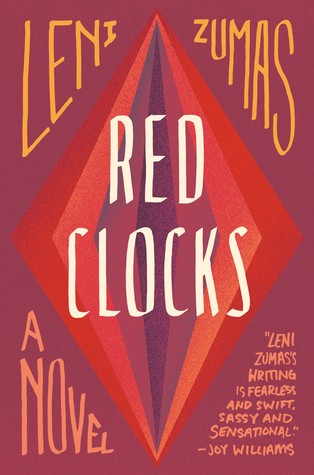Interviews
On Dismantling the Power of White Antifeminist America
Leni Zumas, author of the forthcoming novel ‘Red Clocks,’ discusses writing whiteness, Christian fundamentalism, and the marketing of female roles

Electric Lit is just $4,000 away from our year-end fundraising goal of $35,000! We need to hit this target to get us through the rest of 2025, and balance the budget for 2026. Please give today! DONATE NOW.
I grew up in the America which, until recently, was not often discussed, the one ruled by fundamentalists. My father became a born-again Christian in 1979, the year Jerry Falwell’s Moral Majority swept through the country. The organization was crusading against the “signs of cultural decline”: abortion had been legalized, divorce and access to birth control were contributing to the deterioration of the traditional family unit, and women, homosexuals, and people of color were petitioning for equal rights. With the election of Ronald Reagan, the Moral Majority sought to seize control of the federal government. Reagan promised, as the current inhabitant of the White House has promised, to support conservative judges who respected the sanctity of human life, “traditional family values”, and prayer in public schools.

When I was fifteen, my father sent me to a Christian re-education camp affiliated with Mike Pence. I’ve spent much of my adulthood terrified that Christian extremists would take over America, and, at the same time, irritated that many of my peers seemed oblivious to my concerns — or they did until 2016, when 81% of white evangelicals voted the Religious Right into power with the election of Donald Trump. This past year, as I watched my deepest fears actualize, I was thrilled to discover Leni Zumas’s Red Clocks, a darkly comic novel that explores an America overtaken by Christian extremists. Zumas follows five different women navigating life in a country where the Personhood Amendment has made abortion a crime, IVF is banned, and only married couples are allowed to adopt due to the Every Child Needs Two Amendment.
Zumas is also the author of the short story collection Farewell Navigator and the novel The Listeners, and she teaches in the MFA program at Portland State University. I talked to her about American whiteness: how it feeds an antifeminist political culture, how she writes it, and how the phenomenon inspired Red Clocks.

Deirdre Sugiuchi: I love that Red Clocks is unabashedly focused on being female and having female relationships. In some ways I feel like this is the Gen X novel I have been waiting for, the one that Sassy promised I would read. Can you talk about writing a feminist novel while living in a culture and society that frequently tries to suppress feminist principles?
Leni Zumas: I was a Sassy reader, too. I once searched every drugstore in a ten-mile radius for the issue with Ian Svenonius on the cover, as Sassiest Boy in America.
While I was working on Red Clocks, a shadow-question surfaced: “Are any men going to want to read this?” But why was I asking this question? I doubt Norman Mailer was too worried about The Naked and the Dead having no women in it, or that Ernest Hemingway spent a huge amount of time wondering how female readers would connect with a novel about (mostly) male fighters in the Spanish Civil War.
I’ve spent much of my adulthood terrified that Christian extremists would take over America, and, at the same time, irritated that many of my peers seemed oblivious to my concerns.
Recently someone asked me if I consider Red Clocks to be a feminist novel. When I said “Yes, absolutely,” the woman looked uncomfortable. I am curious about people’s resistance to the term “feminist,” even if the resistance scrapes my nerves. In this case, I was talking with a very intelligent and thoughtful person who believes fiction should be free of ideology. Whereas my take is: nothing is free of ideology. We all see the world through filters. As a feminist I look through a lens of skepticism, alert to what is hidden or buried, watchful for the “violence and power concealed under the languages of civility, happiness, and love” (to borrow a phrase from Sara Ahmed’s brilliant Living a Feminist Life). Consciously and not, my writing bears the imprint of this watchfulness. As Ahmed puts it: “If we have been taught to turn away, we have to learn to turn toward.”
One way I “turn toward” in Red Clocks is by labeling the five main characters according to roles or functions: “Biographer,” “Polar Explorer,” “Wife,” “Mender,” “Daughter.” I wanted to call attention to the inadequacy of labels. All of us have multiple identities — play multiple parts in the world — yet we can find ourselves reduced (by immigration laws, magazine headlines, a conversation with a neighbor) to a single one. Or we may be asked to claim the “core” label, the role that’s more cherished than any other. At the 2012 Democratic National Convention, Michelle Obama said, “At the end of the day, my most important title is still Mom-in-Chief.” Hillary Clinton’s Twitter bio reads as follows: “Wife, mom, grandma, women+kids advocate, FLOTUS, Senator, SecState, hair icon, pantsuit aficionado, 2016 presidential candidate.” Why does “wife” come first? Why does “2016 presidential candidate” come last?
DS: Exactly! It’s such a weird bind to be female, to find yourself so often reduced to one role. I take being a mother very seriously but I never made being a mother the core of my identity. It’s unhealthy. There has been a strange shift in how being a mother, being a good mother, has been marketed over the past two decades. I enjoyed the interplay between the mothers in the book.
LZ: That’s exactly the right word: marketed. Being a mother is a role that gets outrageously sentimentalized, whether it’s by advertisers, screenplays, or your friends on Instagram. My love for my son, age 4, is boundless and joyfully animal, but not simple; in the mother role I feel ambivalence, doubt, conflictedness. I don’t find my experience well represented in the reductive American mythologies.
Being a mother is a role that gets outrageously sentimentalized, whether it’s by advertisers, screenplays, or your friends on Instagram.
In Red Clocks, when Susan (“the Wife”) runs into a fellow mom at a store, she’s overcome with loathing for this woman who feeds her kids homegrown chard and brags about the oldest one testing into a gifted-and-talented program. It’s one of the most cartoonish moments in the book, maybe because the degree of competitiveness, judgment, and performance anxiety among parents — in some pockets of our culture, at least — is so ridiculous.
For complex, thorny, platitude-resisting depictions of motherhood, I recommend Noy Holland’s recent novel, Bird; Sophia Shalmiyev’s forthcoming memoir, Mother Winter; and anything by Elena Ferrante.
DS: Yasmine is not a primary character, but her story is core to the book. Why did you choose to tell her story through the Daughter’s?
LZ: My novel is set in a state with a grim record of white-supremacist laws. Before I moved here, I’d heard Portland described as the whitest city in America, but I was ignorant of the structural racism in Oregon’s history. When it joined the Union in 1859, its constitution banned African Americans from living or owning property in Oregon; this ban stayed on the books until 1926. In the 1920s, the state legislature (which was heavily influenced by Ku Klux Klan members) passed a law barring Japanese Americans from owning land. These are just two of too many examples.
The Daughter (Mattie) is a white person becoming aware of her own whiteness. She is starting to realize how white privilege organizes her place in the world. Her best friend, Yasmine, who is black, has to endure some things that Mattie does not; and the depth of this inequity is revealing itself. The phrase “ignorant white girl” echoes through the book, and in one of the last chapters we learn why Yasmine said this. It was important to me to frame Mattie’s racial identity, more than Yasmine’s, as the site of conflict and unease. In this novel and beyond, I want my work to face the trouble of whiteness: how it’s been constructed, how its power is maintained, how we could imagine dismantling that power. Texts that have deepened my thinking on this question include Toni Morrison’s Playing in the Dark; Claudia Rankine and Beth Loffreda’s foreword to The Racial Imaginary; Ijeoma Oluo’s “The Heart of Whiteness,” an interview with Rachel Dolezal; and Lore Segal’s Her First American, a painfully hilarious novel wherein an Austrian Jewish refugee and a black American intellectual fall in love in 1950s New York.
In this novel and beyond, I want my work to face the trouble of whiteness: how it’s been constructed, how its power is maintained, how we could imagine dismantling that power.
DS: I’ve spent my adulthood frustrated with the lack of awareness of the Religious Right’s impact in our culture as a whole. Even now people don’t seem to realize the import of extremist Neil Gorsuch being appointed to the Supreme Court, of the Department of Justice issuing guidelines to protect religious freedom, and of the Trump Administration allowing employers and insurers to invoke religious and moral beliefs when choosing to cover birth control and other contraceptives. Red Clocks, with its Pink Wall, and Personhood Amendment, and Every Child Needs Two edict, seems prescient. What clued you into writing the hell in which we now live?
LZ: You’ve written elsewhere about the link between the Religious Right and these “re-education” institutions, and I was not surprised to learn that Mike Pence has done fundraising for Crosswinds, an organization tied to your former school. Pence is one of the politicians who helped me imagine our current hell. As governor of Indiana he sought to discipline and punish the bodies of women and LGBTQ people. In 2005 and 2007 he co-sponsored federal legislation that would recognize human zygotes as legal persons, thereby outlawing not only abortion but certain fertility treatments and all non-barrier forms of contraception. In 2016 Pence signed a bill (later blocked by a federal judge) that would require women who have miscarriages or abortions to pay for the fetus’s funeral.
Another radical conservative who gave me ideas for Red Clocks is Paul Ryan, a longtime proponent of so-called personhood amendments. He cosponsored the 2013 Sanctity of Human Life Act, which would grant full legal rights to a fertilized human egg.
DS: Are there any writers who inform your thinking on this matter?
LZ: I’m influenced by texts that worry the membrane between individual fate and collective predicament — that map characters (or narrative personas) onto broader grids of sociopolitical history. One of my longtime favorites in this vein is W. G. Sebald’s The Rings of Saturn. Three that recently blew me away are Hilary Plum’s Watchfires, a lyric memoir/essay-in-fragments about illness, war, family, and the Boston Marathon bombers; C. D. Wright’s One Big Self, a docupoetic photo-and-text series about incarceration in Louisiana; and John Keene’s Counternarratives, a collection of fictions that rip up American history and stitch it back dazzlingly true/askew.
DS: The mender, a forest-dwelling homeopath, helps many of the women in the book heal. Some who are suspicious of her describe her as a witch. This is not the first time you’ve written of witches. When did this fascination begin?
LZ: Like a lot of my fascinations, it started in books. Elizabeth George Speare’s The Witch of Blackbird Pond made a lasting impact, as did, a bit later, The Crucible, The Tempest, Macbeth, and Homer’s Odyssey.
I’m interested in how the figure of the crone — magical, unbeautiful, un(re)productive — defies the order of normative femininity, which wants the female body to be young, pleasing, and fertile. The Mender, Gin Percival, isn’t strictly a crone, but she is definitely not pleasing or compliant. She has stepped away from the order. Chosen to live out of order.
I’m interested in how the figure of the crone — magical, unbeautiful, un(re)productive.
DS: You used to play drums in bands (S-S-S Spectres, The Spells, Red Scare). The main character in your novel The Listeners is a musician coping with the loss of her band. In your short stories and your novels, you write from multiple perspectives. Do you think working and touring in a band contributed to your ability to write characters from different perspectives?
LZ: That’s cool. I hadn’t considered the link between music and multiple perspectives, but it makes sense: melody and counterpoint, echo and refrain, the textures built by different instruments or voices together. The link I’m most aware of is cadence: obviously kind of important for drumming, and crucial to how I think about making sentences. Syllables are beats, and phrases follow the logic of sound before sense. As my hero Virginia Woolf famously said, “Style is a very simple matter: it is all rhythm.”
DS: One of the things I loved about Red Clocks was the banality with which the characters accept tyranny. What are your thoughts on how we, as a society, respond to tyranny?
Susan Sontag says in Regarding the Pain of Others that “compassion is an unstable emotion. It needs to be translated into action, or it withers.” Horrors become familiar, habitual, with enough repetition. Battle footage from Iraq and Afghanistan, flickering for years on laundromat TVs and gym monitors: we stop seeing it. Photos of tiny boats crowded with people fleeing: we stop seeing them. (By “we” I mean Americans with access to television or the Internet.) In Red Clocks, there’s a gradual restoring of visibility, met by terrified recognition, when certain characters wake up to the political facts. It’s a half-waking, not an epiphanic or triumphant one; yet it pricks their numbness. It opens up space for action.









